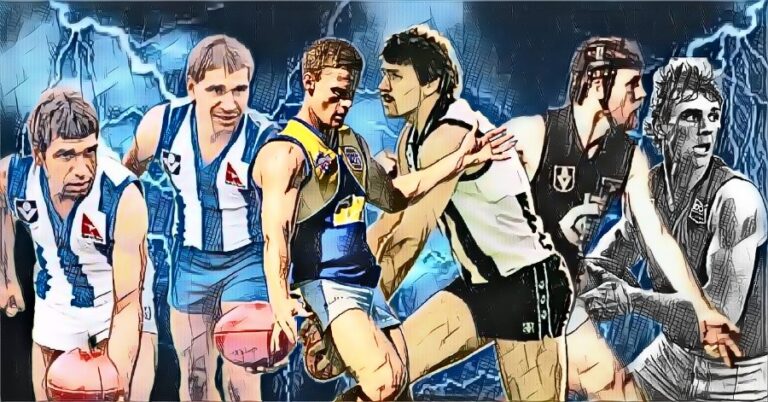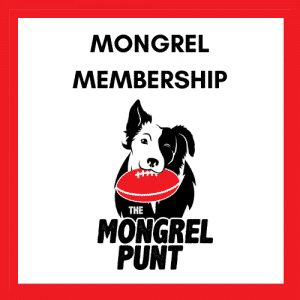Some players stand out in our memories and many of us, myself included, have lionised them over the years, making them seem grander than perhaps they really were.
The AFL Hall of Fame is littered with players who excelled at the highest level and achieved enormous feats of brilliance on the field, but not all players we’ll cover here will have been announced as part of the game’s elite.
Here at The Mongrel Punt, we have always endeavoured to look a little beyond the obvious, flitter between household names and some that maybe… just maybe have slipped your mind over the years.
In this series profiling the heroes of the game, we look at some of the players who were vital to their teams’ success in different capacities.
And believe me – there are plenty of them. And we ask – just how good were they?
You can find the previous two instalments of this series HERE.
GUY MCKENNA
When you think of the wonderful West Coast Eagles teams of the 1990s, you don’t have to look far to find standout players.
Glen Jakovich was one of the very few players to consistently get the better of Wayne Carey, John Worsfold was like a brick wall full of bad intentions, and players like Peter Matera and Peter Sumich grabbed more than their fair share of headlines as matchwinners. Throw in Chris Lewis, Dean Kemp, and Ashley McIntosh, there is a very good reason this team was so successful.
But when you think of those premiership sides and the teams that perennially contended through the decade, there was a man in the back half who held it all together, playing reliably tight when required and becoming an offensive weapon from half-back whenever a turnover was affected.
Guy McKenna was an intercepting and rebounding machine in a time before those stats were kept. Often charged with igniting the Eagles from half-back, his ability to read the play just about better than anyone else in the league at that point saw West Coast cut teams to ribbons on the rebound.
Despite being a three-time All-Australian (and one-time VFL Team of the Year player – this was the AA team before it became an annual accolade), he is criminally underrated, and would be remembered by some of the younger generations as the coach of the Gold Coast Suns more than for his playing exploits, which is a complete shame.
I can remember watching West Coast games from the early 90s and hearing his name called over and over as he clunked a mark, switched the footy, or ran up through the middle of the ground. He barely lost a contest and it was rarer still that he lost his feet. Superbly balanced, always under control, and never even a hint of panic in his game, McKenna was the steadying hand that rested on the shoulder of the West Coast back six’s shoulders. With him there, they just knew that things would be okay.
In later years, he would become club captain, guiding the team into a new millennium before stepping aside to make way for the next generation of premiership stars. He finished with two club best and fairest awards – ten years apart, his form wavering only the slightest throughout his illustrious career in blue and gold.
Guy McKenna was the picture of consistency and his efforts in the defence aided in establishing West Coast as an AFL power. He is one of the unsung greats of the game.
THE KRAKOUER BROTHERS
If you have never sat and watched these two maestros play the game of Australian Rules Football, you are poorer for it.
After playing three seasons at Claremont, Jim and Phil were lured to the bright lights of the VFL and debuted for North Melbourne in 1982. To say they were an immediate hit would be an understatement.
Displaying sublime skills, deft footwork, and with the ability to find each other with no-look handballs, the term “Krakouer Magic” was used often in their first two seasons in the league as people flocked to get a look at these unbelievably talented pair. Whilst the brothers combined brilliantly on the field, they were quite different in terms of their personalities.
Jim was a firebrand, ready to retaliate to some, or all of the taunts he received at the drop of a hat. Phil was more reserved and seemed to be more relaxed on the field. Where Jimmy exuded intensity and an anger bubbling just under the surface, Phil was a sea of tranquillity in comparison. Together, they were the perfect Yin/Yang combination.
Off the field, however, Jimmy often ran into trouble and did jail time as a result.
They combined for 295 games and 467 goals as the terrorised opposition defenders. In a time where not every player was blessed with leg speed and a sudden change of direction, Jim and Phil were ankle-breakers, able to change direction and be off at top pace before their defender had recovered from a cartoonish “where did he go?” type of moment.
In the early 1980s, the VFL had several marquee attractions – Bernie Quinlan, Kevin Bartlett, Leigh Matthews, Kelvin Templeton to name just a few – but I would wager that none genuinely excited the casual supporter quite like the Krakouer Brothers. Their brand of football was something that the league was just starting to see from some of the more nimble players. However, Jim and Phil made them appear as though they were stuck in the mud.
When you watch some of the fleet-footed forwards currently strutting their stuff in the AFL, you can see glimpses of the Krakouer Brothers in their movements. These two were ahead of their time, yet it feels as though they happened along at the exact right moment.
A pair of more brilliant players you will not find – it is about time they were inducted into the AFL Hall of Fame.
As a pair.
As a family.
MERV NEAGLE
I used to live three houses away from Merv Neagle when he played for Essendon in the early 1980s. It was a confusing time for me – I hated Essendon because my family hated Essendon, but here was this bloke who would stop as he walked by, have a chat, talk footy with my Dad, have a laugh, and head to the game.
What the hell was my Dad doing, talking to the enemy like that?
Regardless of how conflicted I was about Merv, I started to pay a lot more attention to the way he played the game. He wasn’t really built like a traditional wingman; I always pictured them as rangy types – like Keith Greig or Robbie Flower. Neagle had some muscle about him and played the position unlike most at that time, except maybe for Robert Dipierdomenico, who took the physicality to a whole new level.
Due to living close by Merv, we’d sometimes get tickets to Windy Hill to watch the Bombers play. The Essendon fans adored him, and when he would tear down the wing, bouncing the footy, the crowd would erupt. I feel dirty writing this – I even cheered for him.
His move to Sydney in 1986 broke more than a few Bomber hearts. We’d moved away by this time – my Dad couldn’t stay in the house where my mother got sick and eventually passed away, but I remember him remaining a force on those Sydney teams in 1987 that went completely nuts, kicking 97 goals in three weeks. Neagle kicked five in one of those games – a star amongst stars. Always.
BRIAN TAYLOR
People, you may not remember much about BT’s footy career, but it is damn well worth getting to know, because as annoying as he can be on commentary, he was just as annoying as a player!
I write that hoping people understand where I am coming from – BT played with passion. Sure, you can construe that as anger, or petulance, but the bloke genuinely cared each and every time he took the field. Every contest, every mark, every goal… it mattered to Taylor.
He emerged at Richmond in the early 1980s and his talent was undeniable. Unfortunately for Taylor, he was in a situation where the Tigers had the dual, and reigning Coleman Medallist on the team – Michael Roach. That meant that BT was either relegated to the second forward spot, which didn’t suit, or the reserves.. which suited him even less.
He got an opportunity in 1982 when Roach was injured and not playing at the level people were accustomed to seeing from him. BT became the go-to forward and went on to kick 71 goals in 15 games. However, it was becoming painfully apparent that the two-headed monster of Roach and Taylor was simply not working. A change was in order.
After transferring to Collingwood for the 1985 season, BT repaid the faith, kicking 80 goals in his first season before winning the Coleman with 100 snags in 1986.
He had brilliant hands (I just reviewed the 1986 WA v Vic State of Origin game – he takes five contested grabs in that one) and was an excellent shot for goal, but all that seems to have been forgotten with his current gig having such a high profile. And if people do remember, they tend to remember him yelling at umpires and threatening them more than they do his impressive football skills.
When BT talks in his role as commentator, many are tempted to turn the volume down, however, when he speaks about goal-kicking and leading patterns, it pays to listen. Watching him in some vintage games recently, it is very apparent that Taylor was born to play full forward – he knows what he is talking about.
In that regard, anyway.
ROD ASHMAN
I hated this bloke growing up… because he was so damn good!
It seemed as though every time my team played Carlton, Ashman would have a field day, collecting the footy in the middle of the ground and drifting forward to punish teams on the scoreboard.
In his 14 seasons in the league, the helmeted rover failed to kick a goal per game just once – in his debut season, and managed to top two goals per game twice.
I find it incredible that he never won a Carlton Best and Fairest, but I guess that is a testament to just how good those Carlton teams were in the late 70s and into the early 80s. They were just stacked with A-Graders, and Ashman was one of them.
Whilst the Blues had plenty of winners throughout this period, Ashman was the one who could tear the heart out of a team and show it to them as they lay dying on the turf. He kicked four or more goals on 19 occasions as he seemed to always get to the right spot to finish off Carlton forward forays, much to the delight of fans at Prices Park.
Ashman fell one vote short of the 1981 Brownlow Medal in a season that saw him average 23 touches and 1.78 goals per game. With names like Doull, Hunter, Johnston, and Jesaulenko at the club at the same time, Ashman is too often forgotten when speaking of the all-time great Carlton players, but not this time. Having seen him destroy my team many times, I’ll never, ever forget.
Like this content? You could buy me a coffee – I do like coffee, but there is no guarantee I won’t use it to buy a doughnut… I like them more. And I am not brought to you by Sportsbet or Ladbrokes… or Bet365, or any of them.



